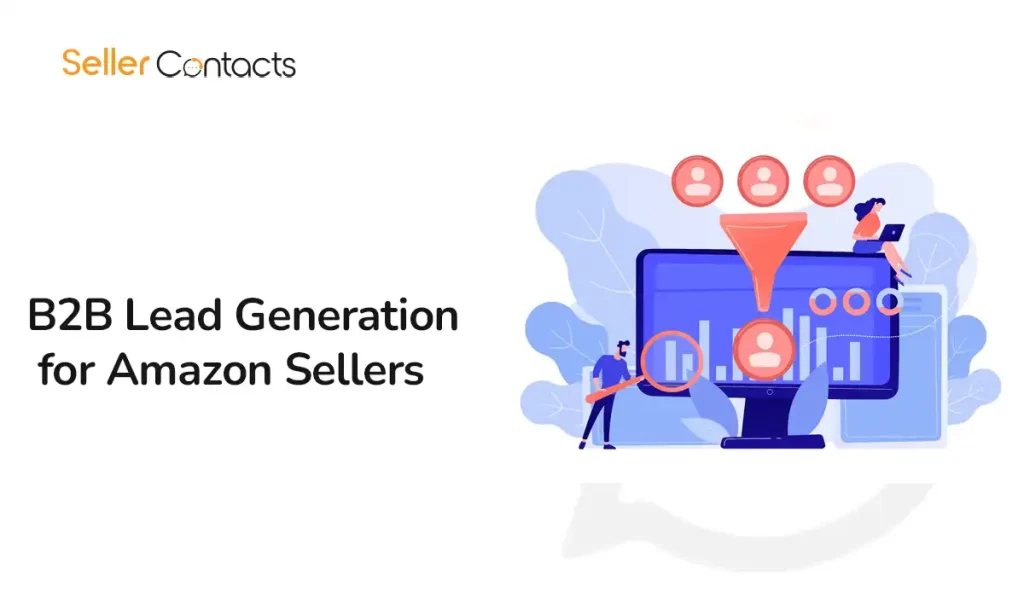B2B Lead Generation for Amazon Sellers

Not every gold rush is made for the average prospector. Some are for those who build the tools, offer the maps, or sell the shovels. That’s where B2B companies come in.
Amazon sellers — from solo entrepreneurs to 7-figure private label brands — are constantly looking for ways to grow. They need better tools, smarter strategies, reliable suppliers, and scalable support systems. This makes them one of the most high-intent, underserved B2B audiences in the digital world.
But most B2B lead gen strategies ignore them.
Why? Because Amazon sellers don’t list themselves in traditional business directories. They operate under brand names. They often hide behind storefronts, not LinkedIn profiles.
And that’s where Seller Contacts changes everything.
This article will show you how to generate high-converting B2B leads from the Amazon seller ecosystem, backed by smart strategies, real-world results, and powerful tools — including Seller Contacts.
Why Traditional Lead Generation Doesn’t Work
The Invisible Seller Problem
Trying to generate B2B leads from Amazon sellers using standard tactics doesn’t go far.
Here’s why:
- Amazon sellers don’t show up on LinkedIn searches easily. Their brand names rarely match their personal profiles.
- They don’t list themselves in B2B directories. No Clutch, no Crunchbase.
- Their email addresses aren’t publicly available. Amazon keeps contact info private.
- Their storefronts don’t tell the full story. You might see a brand name but no idea of revenue, location, or contact path.
You could spend hours scraping, guessing, or cross-referencing — and still not have a clean list to reach out to.
Worse? If your data is wrong or outdated, your outreach fails. You burn your sender reputation and your brand trust.
Why Good Data is the Core of Smart Lead Generation
To do lead generation right, you need:
- Accurate data: not scraped, not stale.
- Segmented filters: so you don’t treat a side-hustler the same as a $10M seller.
- Context: revenue, location, product category, fulfillment method — things that shape your pitch.
That’s what makes the Seller Contacts platform powerful. It doesn’t just give you names. It gives you contextual, up-to-date profiles of Amazon sellers so you can build personalized, effective B2B campaigns.
Proven B2B Lead Generation Strategies for Amazon Sellers
1. Cold Outreach That Speaks Amazon
Cold email isn’t dead. But lazy cold email is.
If you’re reaching out to an Amazon seller, your message should talk like them, think like them, and offer something they care about.
A good cold email to an FBA seller doesn’t say:
“We help eCommerce brands scale their PPC.”
It says:
“We helped a home & kitchen FBA brand drop their ACoS from 48% to 21% in 30 days. Want the exact playbook?”
When you start with seller-specific pain points, your open rates and reply rates jump. Personalization matters — and that’s only possible with the right data.
2. LinkedIn + Enriched Seller Data = Powerful Combo
LinkedIn isn’t the place sellers start, but many brand owners still have profiles.
When you use Seller Contacts to identify a brand name — say, “GlowNest Co.” — and see the registered location is Austin, Texas, you can search LinkedIn for the brand and spot the founder.
A quick connect message like:
“Saw you run GlowNest on Amazon. We work with a few Austin-based brands optimizing their post-purchase flow. Happy to share how we helped NestGlow (similar niche) bump their review rate by 22%.”
That’s not cold. That’s warm, targeted, seller-intelligent outreach.
3. Run Amazon-Centric Webinars and Funnels
Amazon sellers are hungry for growth strategies. If you’re offering anything from PPC audits to fulfillment solutions, bring them in through value-first events.
Set up a landing page:
“3 Advanced Ways to Rank Faster on Amazon in 2025 — Live Workshop”
Then promote it via outreach, ads, and your filtered Seller Contacts list.
Once they register, you’re no longer chasing leads — they’re entering your funnel willingly.
You can also repurpose the content into email sequences and drip campaigns.
Using Seller Contacts to Fuel Your Lead Gen Engine
Why Seller Contacts Works When Everything Else Fails
Most databases fail because they were built by scraping or guessing. Seller Contacts is built from a mix of public marketplace data, proprietary sourcing, and frequent updates, giving you access to:
- Seller Names
- Contact Info (Email/LinkedIn when available)
- Storefront URLs
- Revenue Range
- Fulfillment Method (FBA/FBM)
- Product Categories
- Geo Location
- Brand Names and Store Names
And you can filter with surgical precision. Want to find:
- U.S.-based Amazon sellers doing over $50k/month?
- European private label sellers in the baby category?
- FBA-only brands in health & wellness?
You can do all of that — within seconds.
Example Workflow: From Filter to First Contact in Under 5 Minutes
Let’s say you’re a supplier looking to pitch private label brands in the beauty niche.
- Filter in Seller Contacts:
Country = US
Niche = Beauty & Personal Care
Monthly Revenue = $25k–$250k
Fulfillment = FBA - Export the list with brand name, contact email, and storefront.
- Enrich with LinkedIn if needed (optional but helpful).
- Write targeted emails based on product line and scale (e.g., “We help beauty brands reduce COGS by 12–15% using better MOQ terms.”)
- Send using Instantly or Lemlist, track opens, optimize replies.
That’s it — five minutes to start a relevant, personalized, scalable outreach process.
So what are you waiting for? Visit Seller Contacts and start your B2B lead generation journey today.
